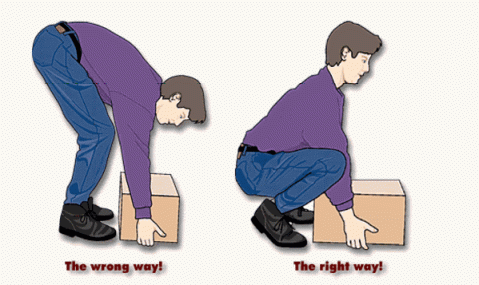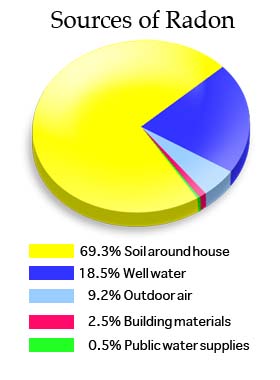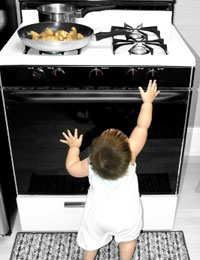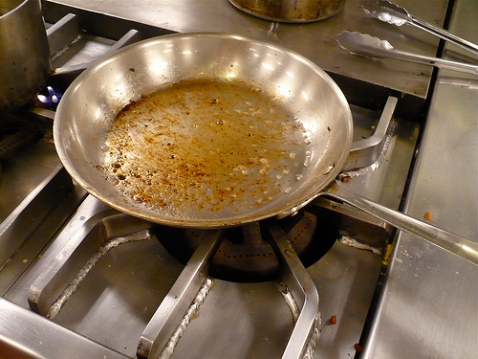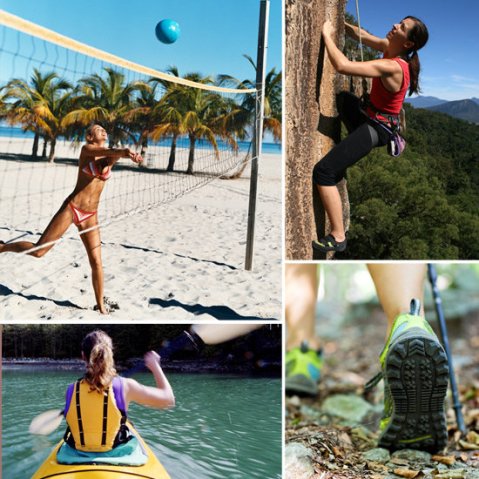Lift with Care to Limit Back Pain
Injuries caused by poor lifting and handling practices can cause major back pain. To avoid these unpleasant and often inhibiting injuries, remember these safe lifting and carrying recommendations while you are doing chores around the house.
Safe Lifting and Handling Techniques
Lifting from ground level:
- Get as close as possible to the load and bend down at your knees; not your back.
- Get a good grip on the object and test its weight.
- Keep the load close to your body and lift up with your legs.
- Be aware of your balance and what part of your body is doing the work – it should be your legs.
Lifting from a shelf, desk or counter:
- Pull the load close to your body and test its weight.
- Shift the weight of the load to your legs by keeping it close.
Lifting from overhead:
- Make certain you are standing on a stable surface before you attempt to lift.
- Test the load to be sure that you can lift it safely.
- Take the object off of the shelf carefully and maintain your balance.
- Maintain control of the load, and bring it down to waist level.
Carrying heavy loads around the house:
- Look ahead to make certain your path is clear.
- Avoid stairs if possible. If you must use the stairs, hold the banister or wall to maintain your balance.
- Have someone else hold doors and gates open for you.
- Change direction by moving your feet, not your hips.
- Keep your shoulders, hips and feet pointing in the same direction.
- Never twist at the waist while you are carrying something heavy.
- Always set the load down if it becomes too heavy to avoid straining a muscle.
Setting down heavy loads:
- Bend at your knees, not your waist and set down the corner of the object closest to you first.
- Remember to keep your fingers out from under the load as you set it down.
Safe lifting and carrying techniques can help you avoid strains, sprains and other painful injuries. Whatever the task at hand, make sure to ask for help from a family member when the load is too heavy for you to handle on your own!
For more information on avoiding back injuries and questions regarding your insurance, contact your agent.
Eliminate Radon Dangers in Your Home
Since you cannot see, smell or taste radon gas, it is not detectable in your home. So, why worry about radon? The National Cancer Institute reports that radon is the second-leading cause of lung cancer in the United States next to smoking.
The prevalence of radon is not isolated to one geographic area or type of home. In fact, one in every 15 homes has an elevated radon level, so it’s important for you to test and eliminate radon dangers at your residence.
What is Radon Gas?
Radon is a naturally-occurring radioactive gas produced by the breakdown of uranium in soil, rocks and water. Since the air pressure in a typical home is lower than the pressure in the soil around the foundation, the home acts like a vacuum and draws radon in through cracks in the foundation.
Radon may also be present in the water source and can be released into the air when water is used for general household purposes such as showering, or ingested when drinking. Testing for radon is the only way to determine if your indoor air quality and/or water are affected.
Testing for Radon
According to the EPA, radon gas levels can vary by day, season and geographic area. The radon levels can even be different in your home as compared to your next door neighbor’s home. Therefore, all potential homebuyers, current homeowners and home sellers should have their homes tested for radon.
The EPA recommends testing for radon under the following circumstances:
- The home was never tested.
- The home was tested more than two years prior.
- The home was renovated since it was last tested.
- You plan to occupy a lower level of the home than what was originally tested, such as the basement.
To test a home for radon, you can order a kit by mail from a qualified radon measurement service provider, purchase a radon kit from a local hardware store or hire a qualified radon tester (often also a home inspector).
If a radon test reveals that your home’s level is dangerous, you can install a radon mitigation system. A qualified radon reduction contractor can install a system in typically less than a day. If your home’s water source has high levels of radon, too, a point-of-entry treatment device can be installed to reduce emissions.
Ensure that your family is breathing easy by testing for radon and installing a radon mitigation system if the gas levels in your home are too high.
For more information on radon testing and your home insurance , contact your agent.
Head Out to Sea Without Injury
Water sports, relaxing in the sun and splashing in the water are great ways to make memories with family and friends. Sea lovers must be careful near the marina and dock, though, to assure that their getaways are safe ones. If you are hitting the opening waters this season, don’t forget these safety tips!
Dock Safety
- Use forward and reverse at an idle speed when docking and moving your boat near the marina.
- Have bumpers, mooring lines and boat hooks ready before docking.
- Keep all body parts in the boat until you have come to a complete stop.
- Tie the line that holds the boat against the wind first when docking.
- Dock at a marina that has stand pipes, fire extinguishers, good lighting, surveillance cameras and security measures in place.
- Always wear personal flotation devices when on the water, especially those than cannot swim and children.
- Do not swim near a marina since boaters cannot see you when they are trying to dock.
- Wear non-slip shoes on the boat and dock.
- When leaving your boat, turn off any portable heaters on board.
- Keep your boat in good condition with all equipment meeting safety standards established in your area.
- Assure that the marina has the proper power voltage for your boat.
- Add fuel to portable tanks on the dock only; never on the deck of your boat.
To avoid a potential fire onboard, inspect fuel hoses and containers on a regular basis to prevent the escaping vapors from going into bilges. Also check the wiring and all appliances on deck for damage frequently.
As a safety precaution, keep fire extinguishers on deck and fit smoke detectors to the cabin.
For more information regarding boat safety and your insurance, contact your agent.
Keeping Babies Safe at Home
Many new parents worry about the dangers their little ones will face outside of the home; however, some of the greatest threats are lurking in the nursery, the kitchen and the bathroom within their homes. In fact, children between the ages of one and four are more likely to get injured by fire, burns, choking, poisoning or falling at home than by violence from a stranger.
To keep your little one safe as they grow, implement these safety precautions in your home:
Baby Safety Recommendations
Choking Prevention
- Put babies to sleep on their backs and keep toys, pillows and excess blankets out of the crib.
- Do not hang ribbons, strings or any items that can be grabbed over a crib.
- Do not give children toys that are not age-appropriate by always reading the manufacturer’s packaging to make sure that it is suitable for their age and ability level.
- Cut the loops of window blind cords into two pieces and place them out of your baby’s reach.
- Monitor your baby while they are eating, drinking or teething. Make sure he/she is upright and not crying when feeding solid foods.
- Mash or grind foods so they are soft enough to gum and swallow.
- Do not feed children peanut butter, popcorn, raw carrots, nuts, grapes or uncooked peas before age three because children often do not chew food before they swallow it.
Fall Prevention:
- Use safety gates at the base and top of staircases.
- Secure children with straps in high chairs, changing tables and strollers.
Poisoning:
- Remove medicines and medical supplies from easily accessible places around the house. Place these items out of your baby’s reach.
- Place cleaning products, alcohol and other poisons in a cabinet with a child safety lock.
- Identify household items that may be toxic to young children. (ex: Iron pills are the leading killer of children under age six).
Water Hazards:
- Place locks on your toilet lids and bathroom doors.
- Do not leave standing water in buckets for your child to access. Small children can drown in as little as two inches of liquid if they fall in.
- Set your water heater to less than 120°F to prevent accidental scalding, and use a water thermometer to test bath water before placing your child in the tub.
Keep your little ones safe every day of their young lives by keeping a close eye on them. For more information regarding baby safety, contact your pediatrician. For more information regarding home insurance, contact your agent.
Golf Cart Safety Tips
As surprising at it may be, there are many golf cart accidents annually, which result in personal injury, property damage and even death. Since golfing is intended to be a fun, relaxing and enjoyable outdoor activity, review the following safety tips to keep you and your fellow golfers safe.
Safety Guidelines
- Drivers and passengers should remain seated while the vehicle is moving at all times.
- Never exceed the maximum capacity for a golf cart – everyone needs his or her own seat.
- Slow down and honk when reaching an “intersection” to alert other drivers and pedestrians of your presence.
- Reduce your speed when approaching pedestrians; they always have the right-of-way. Also, reduce your speed when turning and passing.
- Use the safety mirrors when approaching intersections to ensure that the coast is clear and that you can proceed.
- Your maximum speed will depend on the terrain, weather conditions and the total weight of the vehicle (including passengers and equipment). Generally, you should operate a golf cart at the same speed as a well-paced walk. This means driving no faster than 15 miles per hour.
- Keep your hands, arms, legs and feet inside the golf cart when it is in motion.
- When it is not in use, place the golf cart’s control lever in the “Neutral” position and remove the key.
- Do not go in reverse without looking behind you for potential hazards.
- Do not shift gears while the vehicle is in motion.
- Maintain an adequate distance between you and other drivers, similar to what you do on the roadways in your car.
Much of the same rules and principles apply when driving a golf cart as they do on the road. The bottom line: drive with caution while respecting others. This way, everyone can enjoy the course without having an accident.
We want you to be safe on and off the course. Contact us today to learn about all the ways we help you to protect what matters most!
Using Double-Handed Tools Safely
Even though they are small, hand tools can cause injuries, such as carpal tunnel syndrome, tendonitis and muscle strain. To avoid these injuries, use double-handled hand tools ergonomically and safely by doing the following:
 Use a tool with a grip of at least 2 inches when closed and no more than 3 ½ inches when open for power tasks.
Use a tool with a grip of at least 2 inches when closed and no more than 3 ½ inches when open for power tasks.- Use a tool with a grip span of no less than 1 inch when closed and no more than 3 inches when open for precision tasks.
- Use spring-loaded handle tools only.
- Avoid tools with dull edges or those without finger grooves.
- Select tools with soft material coating and non-slip surfaces.
- Always keep your wrists straight while using hand tools, and select those that can be used in either hand.
- Use tools with a handle longer than the widest part of your hand for high-force tasks.
For more information on tool safety and how it can affect your home insurance, contact your agent.
Taming Grease Flare-Ups
As grease accumulates, it can catch fire. This can expose you to unnecessary fire hazards while using burners, ovens and grills. Luckily, this potential danger is avoidable if the kitchen is kept clean.
- Keep all grilling surfaces clean and free of grease accumulation.
- Empty grease traps frequently and never allow them to overflow.
Learn how to use the class K fire extinguisher in your kitchen BEFORE a potential fire ignites!
Five Spring / Summer Activities to Get You Fit While Having Fun
Looking to mix up your boring fitness routine? Consider swapping your usual run or workout at the gym with one of the following outdoor summer activities that will make you break a sweat while still having fun.
Beach volleyball: If you’re headed to the beach, try starting a pickup game of volleyball, or consider joining a rec league team. A 155-pound person can burn up to 550 calories in 60 minutes!
Inline skating: For a fun way to burn 490 calories in an hour, dust off your old inline skates and take them for a spin. Be sure to wear all the necessary protective gear when you do.
Ultimate Frisbee: A combination of Frisbee and football, this game is a great way to sheds pounds with some friends. A 155- pound person can spend 240 calories in just an hour.
Tennis: If you want a great workout, grab a friend for a game of tennis. During an hour long match you’ll burn 560 calories.
Swimming: On those especially hot days, head to the nearest body of water and go for a swim. Doing laps for an hour will have you burning up to 560 calories!
For more information on life insurance, contact your agent.
Seasonal Travel Safety
With the start of hot weather season comes an increase in traffic, as good weather encourages more people to leave their homes and travel. No matter what puts you on the road this season, remember these simple tips to stay safe all season long:
- Slow Down – In addition to increases in traffic, summer means more road work. Always reduce speed in work zones and allow plenty of space between your vehicle and any workers.
- Plan your route – Driver indecision can be a major cause of traffic problems. Also, attempting to operate a GPS or read a map while driving can be extremely dangerous.
- Watch road conditions – Hot weather heat can change the way that your tires grip the roadway and affect braking. Be especially aware of fresh blacktop on hot days.
For more information on protecting your car this spring/summer and how it can affect your auto insurance, contact your agent.
Parent Teen Driving Agreement
Parent/Teen Driving Agreement
Provided by: Oakland Companies
I, ____________________________, will drive carefully and cautiously and will be courteous to other drivers, bicyclists, and pedestrians at all times.
I promise that I will obey all the rules of the road.
- Always wear a seat belt and make all my passengers buckle up
- Obey all traffic lights, stop signs, other street signs, and road markings
- Stay within the speed limit and drive safely
- Never use the car to race or to try to impress others
- Never give rides to hitchhikers
I promise that I will make sure I can stay focused on driving.
- Drive with both hands on the wheel
- Never eat, drink, or use a cell phone to talk or text while I drive
- Drive only when I am alert and in emotional control
- Call my parents for a ride home if I am impaired in any way that interferes with my ability to drive safely
- Never use headphones to listen to music on an mp3 player or other electronic device while I drive
I promise that I will respect laws about drugs and alcohol.
- Drive only when I am alcohol and drug free
- Never allow any alcohol or illegal drugs in the car
- Never accept a ride if the driver is not also alcohol and drug free
I promise that I will be a responsible driver.
- Drive only when I have permission to use the car and will not let anyone else drive the car unless I have permission
- Drive someone else’s car only if I have parental permission
- Pay for all traffic citations or parking tickets
- Complete my family responsibilities and maintain good grades at school as listed here: ____________________________________________________
- Contribute to the costs of gasoline, maintenance, and insurance as listed here: ____________________________________________________
Additional Promises:
________________________________________________________
________________________________________________________
I agree to the following restrictions, but understand that these restrictions will be modified by my parents as I get more driving experience and demonstrate that I am a responsible driver.
- For the next _____ months, I will not drive after ________ pm.
- For the next _____ months, I will not transport more than _______ teen passengers (unless I am supervised by a responsible adult).
- For the next _____ months, I won’t adjust the stereo, air conditioning/heater or any electronic devices while the car is moving.
- For the next _____ months, I will not drive in bad weather.
- I understand that I am not permitted to drive to off-limit locations or on roads and highways as listed here: ___________________________________________________
- Additional restrictions: __________________________________________
Penalties for contract violations:
|
No driving for ___ months. |
|
No driving for ___ months. |
|
No driving for ___ weeks/months |
|
No driving for ___ weeks/months |
|
No driving for ___ weeks/months |
|
No driving for ___ weeks/months |
I agree to follow all the rules and restrictions in this contract. I understand that my parents will impose penalties including removal of my driving privileges, if I violate the contract. I also understand that my parents will allow me greater driving privileges as I become more experienced and as I demonstrate that I am always a safe and responsible driver.
Signatures:
Driver: ______________________________________________
Date ________________
Parent promise: I also agree to drive safely and to be an excellent role model.
Parent (or guardian): ___________________________________
Date ________________
Parent (or guardian): ___________________________________
Date ________________

